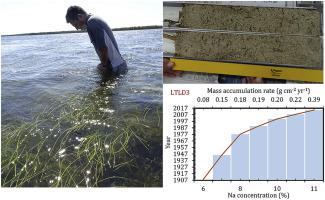Estuarine, Coastal and Shelf Science ( IF 2.6 ) Pub Date : 2020-05-19 , DOI: 10.1016/j.ecss.2020.106843 Ana Carolina Ruiz-Fernández , Joan-Albert Sanchez-Cabeza , Tomasa Cuéllar-Martínez , Libia Hascibe Pérez-Bernal , Vladislav Carnero-Bravo , Enrique Ávila , José Gilberto Cardoso-Mohedano

|
Intertidal ecosystems, such as marshes, mangroves, and seagrasses, contribute to the global carbon storage, helping to regulate atmospheric CO2 concentrations. Organic carbon (Corg) data from seagrass meadows in the Mexican coastline are still scarce, preventing appropriate evaluations of its contribution to mitigate global climate change. Recent temporal changes (≤100 years) of Corg concentrations and burial rates were assessed in 210Pb dated cores from seagrass meadows at Terminos Lagoon, the largest coastal lagoon in the southern Gulf of Mexico. Irrespective of the predominant seagrass species, the cores showed comparable Corg concentrations (0.04–3.9%) and burial rates (2.5 – 66.7 g m−2 yr−1). Increasing salinization, likely caused by sea level rise, favoured Corg concentrations and burial rates in sediments with Halodule wrightii, while in sediments with Thalassia testudinum only Corg burial rates increased, owing to increasing mass accumulation rates, likely promoted by erosion induced by land use changes, and sea level rise. The mean Corg stock (1 m depth; 130 ± 29 Mg ha−1) was comparable with the global average Corg stock for seagrasses in other tropical areas around the world. Our results suggested that, under the current scenario of land use change and marine transgression, the seagrass meadows in Terminos Lagoon preserve the capacity for Corg accumulation and long-term preservation. However, both factors are also known to reduce seagrass resilience caused by water quality deterioration, thus these ecosystems must be monitored and protected from global change impacts, as part of climate change mitigation efforts.
中文翻译:

墨西哥湾南部人为改造的沿海泻湖中海草草甸的盐碱化和有机碳埋葬率提高
潮间带的生态系统,例如沼泽,红树林和海草,有助于全球碳储存,有助于调节大气中的CO 2浓度。墨西哥海岸线海草草地上的有机碳(C org)数据仍然稀缺,无法对其对缓解全球气候变化的贡献进行适当评估。的C最近的时间变化(≤100岁)组织浓度和埋藏率进行了评估210从海草场铅芯月在Terminos泻湖,在墨西哥湾南部的最大的沿海泻湖。不论主要的海草种类如何,其核心均显示出可比的C org浓度(0.04–3.9%)和掩埋率(2.5 – 66.7 g m -2)yr -1)。可能由于海平面上升而引起的盐碱化增加,有利于含卤代氏菌的沉积物中的C org浓度和埋藏率,而对地中海藻类的沉积物中,仅C org埋藏率增加,这是由于质量积累率增加,这可能是由于土地侵蚀造成的。使用变化,海平面上升。平均C org储量(深度1 m; 130±29 Mg ha -1)与全球平均C org相当世界其他热带地区的海草资源。我们的研究结果表明,土地利用变化和海侵的目前的情况下,在Terminos泻湖的海草场保持对C的能力有机的积累和长期保存。但是,众所周知,这两个因素都会降低由水质恶化引起的海草适应力,因此,作为缓解气候变化工作的一部分,必须对这些生态系统进行监控并保护其免受全球变化的影响。











































 京公网安备 11010802027423号
京公网安备 11010802027423号